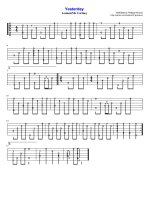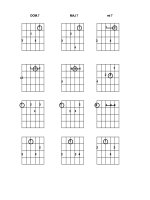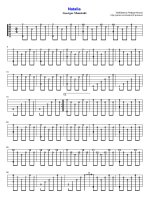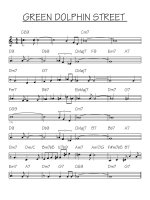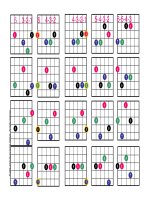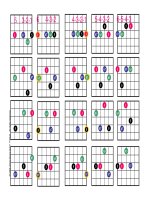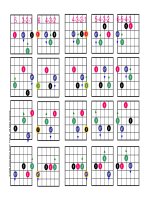Using french vocabulary tủ tài liệu bách khoa
Bạn đang xem bản rút gọn của tài liệu. Xem và tải ngay bản đầy đủ của tài liệu tại đây (2.05 MB, 485 trang )
Using French Vocabulary
This textbook provides a comprehensive and structured vocabulary for all levels
of undergraduate French courses. It offers a broad coverage of the concrete and
abstract vocabulary relating to the physical, cultural, social, commercial and
political environment, as well as exposure to commonly encountered technical
terminology.
Within each section, words and phrases have been grouped into manageable,
assimilable units and broadly `graded! into three levels according to likely
usefulness and dif®culty. The accompanying exercises for private study and
classroom use are designed to reinforce the work done on lists, to develop good
dictionary use, to encourage independent and collaborative learning, to
promote precision and awareness of nuance and register, and to offer the
opportunity for the development of cognate transferable skills, such as
communicative competence, teamwork and problem-solving.
The division of the book into twenty thematic units allows it to be easily
integrated into a modular course structure.
Jean %uffy is Professor of French at the University of Shef®eld. Her book
publications include Colette: Le Ble en herbe (*+8+), Michel Butor: La
Modi®cation (*++0), Structuralism: Theory and Practice (*++2) and Reading
between the Lines: Claude Simon and the Visual Arts (*++8). She is the author of
numerous journal articles.
Companion titles to Using !rench Vocabulary
Using Spanish
A Guide to Contemporary Usage
R. E. Batchelor and C. J. Pountain
[ISBN 0 52* 42123 3 hardback]
[ISBN 0 52* 26987 3 paperback]
Using !rench
A Guide to Contemporary Usage, third edition
R. E. Batchelor and M. H. Offord
[ISBN 0 52* 64177 2 hardback]
[ISBN 0 52* 64593 X paperback]
Using German
A Guide to Contemporary Usage
Martin Durrell
[ISBN 0 52* 42077 6 hardback]
[ISBN 0 52* 31556 3 paperback]
Using Russian
A Guide to Contemporary Usage
Derek Offord
[ISBN 0 52* 45130 2 hardback]
[ISBN 0 52* 45760 2 paperback]
Using Spanish Synonyms
R. E. Batchelor
[ISBN 0 52* 44160 9 hardback]
[ISBN 0 52* 44694 5 paperback]
Using !rench Synonyms
R. E. Batchelor and M. H. Offord
[ISBN 0 52* 37277 * hardback]
[ISBN 0 52* 37878 8 paperback]
Using German Synonyms
Martin Durrell
[ISBN 0 52* 46552 4 hardback]
[ISBN 0 52* 46954 6 paperback]
Using Italian Synonyms
Howard Moss and Vanna Motta
[ISBN 0 52* 47506 6 hardback]
[ISBN 0 52* 47573 2 paperback]
!rench for Marketing
Using French in Media and Communications
R. E. Batchelor and M. Chebi-Saadi
[ISBN 0 52* 58500 7 hardback]
[ISBN 0 52* 58535 X paperback]
Further titles in preparation
Using French Vocabulary
Using French
Vocabulary
J E A N H. % U F F Y
PUBLISHED BY CAMBRIDGE UNIVERSITY PRESS (VIRTUAL PUBLISHING)
FOR AND ON BEHALF OF THE PRESS SYNDICATE OF THE UNIVERSITY OF CAMBRIDGE
The Pitt Building, Trumpington Street, Cambridge CB2 IRP
40 West 20th Street, New York, NY 10011-4211, USA
477 Williamstown Road, Port Melbourne, VIC 3207, Australia
© Jean H. Duffy 1999
This edition © Jean H. Duffy 2003
First published in printed format 1999
A catalogue record for the original printed book is available
from the British Library and from the Library of Congress
Original ISBN 0 521 57040 9 hardback
Original ISBN 0 521 57851 5 paperback
ISBN 0 511 02212 3 virtual (eBooks.com Edition)
Contents
Axknowledgements
&ntroduction
page ix
Aims; structure and organisation; criteria of selection;
exercises; symbols; tips on dictionary use; tips on learning
vocabulary; revision suggestions
*
Unit '
Towns and buildings
Household
Gardens
*6
Unit (
The physical world
The animal world
Weather
36
Unit )
The human body and health
The health service and medicine
57
Unit 4
Physical appearance
Gesture and movement
7+
Unit 5
Personality
Human behaviour
++
Unit ,
Clothes and footwear
Food and drink
*22
Unit -
Perception
Colour and light
Materials and textures
*45
Unit .
Shapes and patterns
Size and quantity
Containers
*63
Unit /
Visual and performing arts
Media and popular culture
*85
Unit '0
Literature and literary criticism
Speaking, reading and writing
206
Unit ''
Leisure and sport
224
Unit '(
Tourism, travel and transport
243
Unit ')
Family, birth, death and marriage
Religion
260
vii
viii
List of contents
Unit '4
Education and science
277
Unit '5
Agriculture and industry
2+5
Unit ',
Business and commerce
Employment
3*5
Unit '-
The of®ce and computing
Post and telecommunications
338
Unit '.
Law and ®nance
357
Unit '/
Geography, history and war
382
Unit (0
Politics and international relations
Public services, social and environmental issues
406
Answers to the exercises
42+
Acknowledgements
I am grateful to all copyright holders for permission to reproduce the
extracts used in this book. Every possible effort has been made to trace
and acknowledge ownership of copyright; I apologise for any omissions
and would welcome these being brought to my attention.
I should like to express my warm thanks to FreÂdeÂrique %avid for her
invaluable comments on the ®rst draft of the manuscript, Kate Brett for
her constructive editorial advice and support and Sara Barnes for her
conscientious copy-editing. I should also like to thank past and present
students for their helpful feedback on sample materials. Finally, I am
deeply indebted to Paul Marshall and Mary %uffy for their support,
understanding and encouragement.
ix
Introduction
Aims
Using French Vocabulary is designed to provide students of French with
a comprehensive and structured vocabulary book which can be used at
all levels of undergraduate French programmes. To the dual or single
honours student, it offers broad coverage of the concrete and abstract
vocabulary relating to the physical, cultural, social, commercial and
political environment, as well as exposure to commonly encountered
technical terminology. While the principal target audience is the
university or college student, many of the units could also be readily
adapted to and integrated into `Language for Special Purposes' courses.
Vocabulary acquisition is often a fraught issue for both teachers and
learners of languages. No language teacher would dispute the
importance of setting realistic and measurable learning objectives.
However, while the many excellent language textbooks which have been
published in recent years provide a wealth of authentic target language
materials and co-ordinated exercises, the student's lexical exposure
often remains limited to the vocabulary which `crops up' in the texts
and recordings studied in class. Many students devote considerable time
and effort to the compilation of vocabulary notebooks in order to
supplement classwork and to ®ll gaps in their knowledge, but, by its
nature, such supplementary work is very time-consuming and
somewhat erratic in its outcomes. Furthermore, students are often
disheartened not only by the sheer labour involved in vocabulary
notation, but also by their uncertainty regarding what they are expected
to know and what they can expect of themselves at a given stage in their
university or college course. Much anxiety is generated by speculation
regarding what is `likely to come up' in examinations and tests, and
both teachers and students recognise that a single lexical gap can
sabotage the comprehension and translation of an entire phrase or
sentence. In recent years many attempts have been made to alleviate
these problems by the writers and publishers of French textbooks. In
the course of the last decade a substantial number of high quality
general vocabulary books and specialised glossaries have been
published.1 However, very few of these books provide reinforcement
exercises and none of them attempts to de®ne learning goals for
particular levels of competence or to grade lexical items according to
usefulness, dif®culty and likely frequency of occurrence. Most standard
vocabulary textbooks offer a single learning strategy: memorisation.
1
See bibliography
1
2
Introduction
Although few would dispute the argument that rote-learning has a place
in any subject requiring the acquisition of rules and the mastery of
meanings and de®nitions, much of the effort expended will be wasted if
the memorised items are not put into practice. While recognising that
there is no substitute for total linguistic and cultural immersion in a
francophone country, this book is distinguished from standard
vocabulary books by its more methodical, graduated approach to
vocabulary acquisition, by its provision of a varied menu of
reinforcement and exploitation exercises and by its emphasis on
proactive, self-instructional approaches to vocabulary expansion.
The broad aims of the book can be summarised as follows:
. to provide a textbook which can be used throughout the
undergraduate degree course and which meets the needs of a modular
programme
. to provide a practical topic-based vocabulary which will constitute a
sound basis for communication in a wide range of circumstances
. to promote the self-instructional learning process
. to facilitate the acquisition of vocabulary by the grading of word-lists
according to the needs and levels of students
. to provide exercises for private study and classroom use which will
reinforce the work done on lists, develop good dictionary use,
encourage independent and collaborative learning, promote precision
and awareness of nuance and register and offer the opportunity for
the development of cognate transferable skills such as communicative
competence, teamwork and problem-solving.
Structure and
organisation
The organisation and ordering of word-lists have been determined by
the principal objectives of the book. The division of the book into
twenty units allows it to be easily integrated into a modular course
structure, either as a set text or as a supplementary self-instructional
learning aid. Words and phrases have been grouped according to topic
in order to assist students in the acquisition of a corpus of vocabulary
relating to the situations and issues which they are most likely to
encounter inside and outside the classroom. Within units, words have
been arranged in such a way as to facilitate assimilation: generically
related items will normally be listed together; synonyms and antonyms
are normally included in the same sub-section; items which are usually
found in a particular place or context, which are used for similar
purposes (e.g. household appliances, tools, etc.), which refer to the
members of a particular social group or species or which are associated
with related activities will be grouped together. Finally, the book tries to
establish a balance between breadth and depth by graduating the
acquisition of topic-related vocabulary sets. Thus, within each section,
words and phrases have been grouped into manageable, assimilable units
and broadly `graded' according to likely usefulness and dif®culty. Such
a structure not only encourages students to see vocabulary acquisition as
a `building-blocks' process, but also provides a working de®nition of
Introduction
3
goals and expectations for a given level and a structure in which
specialisation and re®nement of knowledge can be measured.
Criteria of
selection
The selection and grading of lexical items for a textbook inevitably
involve somewhat arbitrary decisions. The concern to establish units of
a regular and manageable length was a major factor in the determination
of `cut-off ' points. The textbook is, above all, a learning tool and its
usefulness and effectiveness will depend to a large extent on its ease of
handling for both students and teachers and on the setting of reasonable
and realistic assimilation targets. Within units, the distribution of
individual lexical items according to level has been based not on
statistical analysis, but upon my own experience of teaching French at
all levels within the undergraduate degree programme. My prime
criterion has been likely frequency of need and encounter in a variety of
linguistic contexts.
I have selected items which students are unlikely to know already or
which they may have encountered and which they understand, but
which they may have dif®culty in retrieving in an active context. Many
students express frustration concerning their defective retention of
concrete vocabulary and maintain that they seem to forget everyday
functional words more readily than abstract/discursive vocabulary.
Thus, most of the units include substantial glossaries relating to the
objects, tools and commodities associated with particular activities and
practical situations. Also included are terms from a wide range of
spheres which one would expect the well-informed, advanced language
learner to know. Thus, the units on the arts, media, education,
medicine, science, religion, history, geography, law, ®nance, and politics
expose students to the vocabulary which they are likely to encounter in
the press, on television and in standard textbooks in other disciplines. I
have omitted exclusively specialist terms, but have tried to take into
account the ways in which certain technical words ®lter into everyday
language (e.g. medical, legal, computing and industrial terminology).
Finally, I have included items (e.g. unexpected genders and spellings,
faux amis) which pose particular assimilation dif®culties.
Exercises
The exercises which accompany the word-lists are designed to reinforce
the learning process and to encourage recognition, accurate use and
creative exploitation of the acquired lexical items in a variety of
contexts. A substantial proportion of the exercises are self-instructional
in nature, encouraging students to expand vocabulary through personal
lexical research using both bilingual and monolingual sources. The
provision of keys and `fair copies' for certain exercises allows students
to gauge their own progress and assess their own work. Other exercises
are designed for various types of class-work, including oral presentation
and translation, group work and paired activities. While the range of the
accompanying exercises re¯ects a general concern to maintain interest
and concentration through variety, individual exercises have been
4
Introduction
designed to develop quite speci®c skills. These skills relate not only to
linguistic competence, but also to more broadly `transferable' skills such
as analysis, synthesis, deduction, lateral thinking, problem-solving
strategy and the development of effective collaborative methods and
teamwork. The following outline identi®es the speci®c aims of each type
of exercise.
Exercises
Aims
Differentiation
to promote precise and lucid exposition in French
to draw attention to crucial differences between
semantically or formally related words
De®nition
to promote precision of expression and lucid
exposition
to promote ef®cient use of monolingual dictionaries
to encourage lateral thinking in French (as opposed to
word-for-word translation)
Matching word and de®nition
to reinforce work done on vocabulary lists, to remind
students of the meanings of the more technical items
in the lists
to encourage good dictionary practice and the
differentiation of related terms
Translation of idioms
(to and from French)
to familiarise students with commonly used idioms
and to encourage the checking and notation of the
`locutions' associated with a given word
Identi®cation of standard register
equivalents of familiar words and
expressions
to promote an awareness of register and contextual
appropriateness
Translation of brief expressions
involving a single French or English
word
to highlight idiomatic differences between the two
languages
to encourage students to see the individual lexical
item as a springboard for further lexical research.
Composition of sentences
to promote the production of convincing French
sentences in which idiom and register are compatible
with context
Composition of lists of words
with a common root
to develop an awareness of the principles of word
formation in French (e.g. the verbal pre®x and the
formation of nouns; differences between French and
English suf®xation, etc.)
Identi®cation of alternative or multiple to promote an awareness of polyvalence
meanings of common words
to promote good dictionary practice and
to eliminate common errors made by students in
translation
Introduction
5
Gap completion
to develop and test awareness of the suitability of a
word in a given context
to re®ne understanding of the application of terms
which belong to particular lexical sets
Translation into French
to encourage active use of the vocabulary given in a
particular unit
to permit students (and their teachers) to measure
success in acquiring the vocabulary of a particular unit
Translation from French
to encourage students to resolve problems
encountered in translating authentic French language
materials
to make them aware of the differences between
`knowing' a word and translating it effectively in
context.
Group oral translation from French
to develop standard translation skills
to promote awareness of the role of interpretation in
translation
to highlight the usefulness of consultation and
collaboration in translation work
to promote negotiating skills
Group projects
to promote constructive interaction among learners
to develop competence in the generation of convincing
French discourse appropriate to a range of given
contexts
Etudes de texte
to encourage students to read authentic language
materials in an analytical way (i.e. to encourage them
to go beyond broad understanding and to use texts as
lexical and idiomatic resources)
Composition
to give students the opportunity to exploit the vocabulary
which they have acquired in a relatively free manner
(the exercises will be `structured' to varying degrees).
Word games
to reinforce work on vocabulary lists
to re®ne competence in comprehension, de®nition and
differentiation
Multiple choice
to re®ne competence in differentiation and
comprehension
Role-play
to promote interaction among learners and to develop
effective communication and linguistic responsiveness
in a practical situation
ReÂsumeÂ
to develop competence in synthesis and paraphrasing
to re®ne competence in comprehension
to promote active reading approaches to authentic
French language materials
6
Guide to
symbols
Introduction
.
.
.
Tips on
dictionary
use
Register is indicated as follows: Â elevated, formal language
À colloquialism, slang
`Dif®cult' genders are indicated in bold: le, la, (m), (f )
Exercises for which answers are provided are indicated by 3
, Familiarise yourself with the conventions, symbols and abbreviations of
the dictionary. Pay particular attention to the markers relating to
register and archaism.
, Familiarise yourself with the phonetic conventions used in the
dictionary.
, Use bilingual and monolingual dictionaries in tandem. Where bilingual
dictionaries offer a range of translations for a given word, check usage
in a good monolingual dictionary.
, Remember that you may need to consult several dictionaries to ®nd the
best translation of a given word, expression or construction.
, Check cross-referenced entries within dictionaries.
, Read the full entry for a given lexical item. The word you are
researching may have multiple secondary senses or may ®gure in a
number of set expressions with distinctive idiomatic meanings.
, When you look up a word check the entries which precede and follow it.
These entries may be derived from the same root. It is often easier to
learn words in semantically and etymologically related groups than as
separate lexical items.
, Some dictionaries list synonyms and antonyms. Check these sections
when you consult entries and note useful, unfamiliar words.
, Make a note of the nouns, verbs, adjectives, and adverbs formed from a
basic stem. Pay particular attention to the ways in which nouns are
derived from verbs and note differences between nominal endings in
French and English.
, Note and learn constructions which combine verbs, nouns and
adjectives with particular prepositions.
, Note and learn `dif®cult' or `surprising' genders. Pay particular
attention to nouns which have two genders.
, Pay close attention to patterns of pre®xation and suf®xation. Master the
rules relating to suf®xation and gender. (You will ®nd a section on the
topic in most advanced French grammar books.)
, Note and learn constructions which require the use of the subjunctive.
, Note and learn `faux amis' and homonyms.
, Use the dictionary as a resource for active learning. In the course of
consultation, you will encounter innumerable words and expressions
which may not serve your immediate purposes, but which will be useful
to you in other contexts. Note useful unfamiliar vocabulary and
locutions. Build regular, short time-slots into your programme for
dictionary browsing.
, Familiarise yourself with the various facilities of electronic dictionaries
(e.g. Le Robert eÂlectronique, Oxford Superlex, Larousse Unabridged French
Dictionary on CD-ROM). The electronic dictionary makes browsing
much easier and quicker.
Introduction
Tips on
learning
vocabulary
7
- Pay close attention not only to the word, but also to register and, in the
-
-
Revision
suggestions for
the mastery of
vocabularyrelated
grammatical
points
case of nouns, to gender. Mark irregular verbs, irregular adverbs and
learn adjectives which are invariable or which have irregular feminine or
plural forms.
Build regular, short slots into your timetable for the learning of the lists
in this book plus those which you have compiled yourself. Intensive,
brainstorming revision preceding examinations is unlikely to yield good
results. Long-term retention depends on regular learning and revision.
Repeat some of the reinforcement exercises in this book at intervals of
one week, one month, three months. This will allow you to gauge your
success at long-term retention and will highlight areas requiring revision.
When in doubt, verify your understanding of the meaning and use of
unfamiliar words and idiomatic phrases with a native French language
speaker.
Use the authentic language materials which you encounter on your
programme as language learning resources for proactive lexical enquiry.
These resources include language textbooks, set texts for your literary,
cultural and areas studies courses, television and radio programmes,
newspapers, magazines and academic journals.
Form a tutorial partnership with another class-member. Negotiate a list
of common words which will form the basis of a lexical search. Agree on
the distribution of labour. Share the results of your enquiries. Prepare
brief vocabulary tests for each other.
Use and omission of articles
Parts of the body
. Hawkins and Towell, French Grammar and Usage, pp. 31±2
. Lang and Perez, Modern French Grammar, p. 17
. Wakely and Be
 joint, French Usage, pp. 169±78
. Astington, French Structures, pp. 17±19
. Ferrar, A French Reference Grammar, pp. 125±6
. Worth-Stylianou, French: A Handbook of Grammar, Current Usage and
Word Power, p. 12
. Judge and Healey, A Reference Grammar of Modern French, pp. 29±30
Employment
. Hawkins and Towell, French Grammar and Usage, pp. 189±90
. Lang and Perez, Modern French Grammar, p. 22
. Ferrar, A French Reference Grammar, p. 134
. Worth-Stylianou, French: A Handbook of Grammar, Current Usage and
Word Power, p. 8
. Judge and Healey, A Reference Grammar of Modern French, p. 32
Religion and festivals
. Wakely and Be
 joint, French Usage, pp. 182±6
. Lang and Perez, Modern French Grammar, pp. 18±19
Abstract Nouns
. Ferrar, A French Reference Grammar, pp. 132±3
8
Introduction
.
.
Astington, French Structures, p. 16
Worth-Stylianou, French: A Handbook of Grammar, Current Usage and
Word Power, pp. 10±11
Titles
. Hawkins and Towell, French Grammar and Usage, p. 31
. Wakely and Be
 joint, French Usage, pp. 197±202
. Lang and Perez, Modern French Grammar, pp. 20±1
. Ferrar, A French Reference Grammar, pp. 126±7
. Grew and Olivier, 1001 Pitfalls in French, p. 186
. Judge and Healey, A Reference Grammar of Modern French, pp. 28±9
Geographical names
. Batchelor and Offord, Using French, pp. 259±68
. Hawkins and Towell, French Grammar and Usage, pp. 29±30
. Lang and Perez, Modern French Grammar, p. 20
. Wakely and Be
 joint, French Usage, pp. 29±69
. Ferrar, A French Reference Grammar, pp. 127±8
. Astington, French Structures, pp. 19±21
. Worth-Stylianou, French: A Handbook of Grammar, Current Usage and
Word Power, p.11
Names of languages
. Hawkins and Towell, French Grammar and Usage, p. 30
. Lang and Perez, Modern French Grammar, p. 21
. Worth-Stylianou, French: A Handbook of Grammar, Current Usage and
Word Power, p.11
Seasons
. Hawkins and Towell, French Grammar and Usage, p. 30
. Judge and Healey, A Reference Grammar of Modern French, p.29
. Lang and Perez, Modern French Grammar, p. 18
Quantities, speed and price
. Hawkins and Towell, French Grammar and Usage, p. 31
. Lang and Perez, Modern French Grammar, p. 88
. Ferrar, A French Reference Grammar, p. 124
. Judge and Healey, A Reference Grammar of Modern French, p. 29
Games and sports
. Wakely and Be
 joint, French Usage, pp. 195±7
Set phrases
Hawkins and Towell, French Grammar and Usage, p. 40
. Ferrar, A French Reference Grammar, p. 137
. Judge and Healey, A Reference Grammar of Modern French, p. 29
.
Nouns
Gender and number
. Hawkins and Towell, French Grammar and Usage, pp. 4±26
Introduction
.
.
.
.
.
.
.
9
Batchelor and Offord, Using French, pp. 149±59
Lang and Perez, Modern French Grammar, pp. 35±9
Worth-Stylianou, French: A Handbook of Grammar, Current Usage and
Word Power, pp. 16±34
Ferrar, A French Reference Grammar, pp. 138±54
Grew and Olivier, 1001 Pitfalls in French, pp. 18±28
Judge and Healey, A Reference Grammar of Modern French, pp. 4±11
Bonnard, Code du francËais courant, pp. 141±9
Patterns of pre®xation and suf®xation
. Judge and Healey, A Reference Grammar of Modern French, pp. 16±17
. Bonnard, Code du franc
Ëais courant, p. 113
Patterns of nominalisation
. Astington, French Structures, pp. 200±5
Compound nouns
. Hawkins and Towell, French Grammar and Usage, pp. 17±20, 22±5
. Batchelor and Offord, Using French, p. 151
. Lang and Perez, Modern French Grammar, pp. 39±42
. Astington, French Structures, pp. 10±14
. Wakely and Be
 joint, French Usage, pp. 143±4, 145±6, 148±9, 152,
154, 156±7, 159±162, 166
. Judge and Healey, A Reference Grammar of Modern French, pp. 11±12,
17±23
. Bonnard, Code du franc
Ëais courant, p. 120
Collective nouns
. Wakely and Be
 joint, French Usage, pp. 88±90
. Ferrar, A French Reference Grammar, pp. 114±15
Adjectives
Position of adjectives
. Batchelor and Offord, Using French, pp. 160±5
. Hawkins and Towell, French Grammar and Usage, pp. 87±8
. Lang and Perez, Modern French Grammar, pp. 42±4
. Astington, French Structures, pp. 25±7
. Ferrar, A French Reference Grammar, pp. 155±9
. Grew and Olivier, 1001 Pitfalls in French, pp. 14±17
. Worth-Stylianou, French: A Handbook of Grammar, Current Usage and
Word Power, pp. 43±7
Irregular adjectives
. Hawkins and Towell, French Grammar and Usage, pp. 90±4
. Lang and Perez, Modern French Grammar, pp. 45±7
. Grew and Olivier, 1001 Pitfalls in French, pp. 11±12
. Worth-Stylianou, French: A Handbook of Grammar, Current Usage and
Word Power, pp. 35±7
. Judge and Healey, A Reference Grammar of Modern French, pp. 264±6
. Ferrar, A French Reference Grammar, pp. 146±8
10
Introduction
Adjectives of colour
. Hawkins and Towell, French Grammar and Usage, pp. 95±6
. Lang and Perez, Modern French Grammar, pp. 47±8
. Wakely and Be
 joint, French Usage, pp. 134±7
. Astington, French Structures, pp. 27±8
. Worth-Stylianou, French: A Handbook of Grammar, Current Usage and
Word Power, p. 42
. Bonnard, Code du franc
Ëais courant, p. 156
Compound adjectives
. Hawkins and Towell, French Grammar and Usage, pp. 96±7
. Astington, French Structures, pp. 27±8
. Judge and Healey, A Reference Grammar of Modern French, p. 271
. Bonnard, Code du franc
Ëais courant, p. 121
Adjectival phrases
. Hawkins and Towell, French Grammar and Usage, p. 38
Adjectives used as nouns
Hawkins and Towell, French Grammar and Usage, pp. 89±90
. Astington, French Structures, pp. 28±9
. Judge and Healey, A Reference Grammar of Modern French, p. 274
.
Adjectives used as adverbs
. Hawkins and Towell, French Grammar and Usage, p. 90
. Astington, French Structures, p. 31
. Grew and Olivier, 1001 Pitfalls in French, pp. 13±14
. Worth-Stylianou French: A Handbook of Grammar, Current Usage and
Word Power, pp. 42±3
Formation of adjectives from nouns
. Astington, French Structures, pp. 205±6, 207±10
Formation of adjectives from verbs
. Astington, French Structures, pp. 206±7
Numbers and measurements
Cardinal and ordinal numbers
. Hawkins and Towell, French Grammar and Usage, pp. 130±7
. Batchelor and Offord, Using French, p. 148
. Lang and Perez, Modern French Grammar, pp. 83±8
. Ferrar, A French Reference Grammar, pp. 181±98
. Wakely and Be
 joint, French Usage, pp. 80±8
. Judge and Healey, A Reference Grammar of Modern French, pp. 45±50
Measurements and space
. Hawkins and Towell, French Grammar and Usage, pp. 142±4
. Batchelor and Offord, Using French, p. 147
. Wakely and Be
 joint, French Usage, pp. 77±9, 93±102
. Lang and Perez, Modern French Grammar, pp. 89±90
Introduction
Capacity and volume
. Batchelor and Offord, Using French, p. 147
. Wakely and Be
 joint, French Usage, pp. 92±3, 103±4
. Lang and Perez, Modern French Grammar, p. 90
Verbs
Pronominal verbs with re¯exive or reciprocal meanings
. Hawkins and Towell, French Grammar and Usage, pp. 201±3, 205±6
Pronominal verbs without re¯exive or reciprocal meanings
. Hawkins and Towell, French Grammar and Usage, pp. 203±5
. Astington, French Structures, p. 51
Future tense as an indicator of speculation
. Hawkins and Towell, French Grammar and Usage, p. 232
. Astington, French Structures, p. 70
Conditional tense as an indicator of allegation
. Hawkins and Towell, French Grammar and Usage, p. 234
. Astington, French Structures, p. 70
. Judge and Healey, A Reference Grammar of Modern French, p. 163
Formation of verbs from nouns and adjectives
. Astington, French Structures, pp. 210±13
Prepositions
Adjectives followed by a preposition
. Hawkins and Towell, French Grammar and Usage, pp. 293±5
. Batchelor and Offord, Using French, pp. 184±5
Verbs followed by a preposition
. Hawkins and Towell, French Grammar and Usage, pp. 281±92,
298±304
. Batchelor and Offord, Using French, pp. 174±83
Nouns followed by a preposition
. Hawkins and Towell, French Grammar and Usage, pp. 295±7
. Batchelor and Offord, Using French, pp. 184±5
Use of aÁ to indicate purpose/function
. Hawkins and Towell, French Grammar and Usage, p. 296
. Wakely and Be
 joint, French Usage, pp. 213±14
. Ferrar, A French Reference Grammar, p. 277
Prepositions and names of materials
. Hawkins and Towell, French Grammar and Usage, pp. 318
. Wakely and Be
 joint, French Usage, pp. 123±33
. Judge and Healey, A Reference Grammar of Modern French, p. 334
. Ferrar, A French Reference Grammar, pp. 280, 282
11
12
Introduction
Prepositions and clothing
. Hawkins and Towell, French Grammar and Usage, p. 314
. Lang and Perez, Modern French Grammar, p. 166
. Ferrar, A French Reference Grammar, p. 282
Bibliography
General vocabulary books
Christie, Barbara I. and MaÁiri MacGinn, 5,000 French Words (Glasgow:
HarperCollins, 1979)
Gusdorf, Florent, Words: MeÂdiascopie du vocabulaire anglais (Paris:
Editions Marketing, `Ellipses', 1991)
Gusdorf, Florent, Words: Classes PreÂparatoires, H.E.C. (Paris: Editions
Marketing, `Ellipses', 1991)
Gusdorf, Florent, Words: Terminales (Paris: Editions Marketing,
`Ellipses', 1991)
Rafroidi, Patrick, MicheÁle Plaisant and Douglas J. Shott, Manuel de
l'Angliciste, II (Paris: O.C.D.L., 1966)
Rey, J., C. Bousscaren and A. Mounolou, Le Mot et l'IdeÂe
(Paris: Ophrys, 1990)
Rowlinson, William, 10,000 French Words (Oxford and New York:
Oxford University Press, 1991)
Thomson, Megan, 10,000 French Words (Glasgow: HarperCollins,
1993)
Walter, Elizabeth (ed.) Cambridge Word Routes: Anglais-FrancËais,
Lexique theÂmatique de l'anglais courant (Cambridge University Press,
1994)
Dictionaries
Collins Robert French-English English-French Dictionary (Glasgow: Paris:
HarperCollins: Dictionnaires Le Robert, 1996)
Le Nouveau Petit Robert: dictionnaire alphabeÂtique et analogique de la
langue francËaise, updated and revised, edited by Josette Rey-Debove
and Alain Rey (Paris: Le Robert, 1993)
Le Robert et Collins du Management (Paris: Dictionnaires Le Robert,
1992)
The Oxford-Duden Pictorial French-English Dictionary (Oxford,
Clarendon, 1983, revised edition 1996)
The Oxford-Hachette French dictionary: French-English, English-French,
edited by Marie-HeÂleÁne CorreÂard, Valerie Grundy (Oxford
University Press, 1994)
Dictionaries of synonyms, analogical dictionaries
Batchelor, R. E. and M. H. Offord, Using French Synonyms (Cambridge
University Press, 1993)
Bertaud du Chazaud, Henri, Dictionnaire des synonymes (Paris: Robert,
`Les usuels du Robert', 1989)
Introduction
13
Niobey, Georges, (ed.) Nouveau dictionnaire analogique (Paris: Larousse,
1991)
PeÂchoin, Daniel, (ed.) TheÂsaurus (Paris: Larousse, 1992)
`Faux amis'
Kirk-Greene, C. W. E., NTC's Dictionary of Faux Amis (Lincolnwood,
Illinois: National Textbook Company, 1990, ®rst edition 1981)
Thody, Philip and Howard Evans with Gwilym Rees, Faux amis & key
words (London: Athlone, 1985)
Slang
Adrienne, The gimmick 1 : Spoken American and English (Paris:
Flammarion, 1971)
Adrienne, The gimmick 2 : Spoken American and English (Paris:
Flammarion, 1972)
Adrienne, The gimmick 3 : Spoken American and English (Paris:
Flammarion, 1978)
Caradec, FrancËois, N'ayons pas peur des mots : dictionnaire du francËais
argotique et populaire (Paris: Larousse, 1988)
HeÂrail, Rene James and Edwin A. Lovatt, Dictionary of Modern
Colloquial French (London: Routledge, 1984)
Marks, Georgette A. and Charles B. Johnson, Harrap's slang dictionary :
English-French/French-English, completely revised and edited by
Jane Pratt (London: Harrap, 1984)
General
Astington, Eric, French Structures (London and Glasgow: William
Collins Sons and Company, 1980)
Batchelor, R. E. and M. H. Offord, Using French: a guide to
contemporary usage, 2nd edition (Cambridge University Press, 1993,
®rst edition entitled A Guide to Contemporary French Usage, 1982)
Bonnard, Henri, Code du francËais courant (Paris: Magnard, 1981)
Danilo, Michel, J.-L. Penfornis and M. Lincoln, Le FrancËais de la
communication professionnelle (Paris: CLE International, 1993)
Ferrar, H. A French Reference Grammar (London: Oxford University
Press, 1955, revised edition 1967)
Grew, James H. and Daniel D. Olivier, 1001 Pitfalls in French (New
York: Barron's Educational Series,1986)
Hawkins, Roger and Richard Towell, French Grammar and Usage
(London: Arnold, 1996)
Judge, Anne and F. G. Healey, A Reference Grammar of Modern French
(London: Arnold, 1983)
Lang, Margaret and Isabelle Perez, Modern French Grammar: A
Practical Guide (London: Routledge, 1996)
14
Introduction
Wakely, Richard and Henri BeÂjoint, French Usage (Oxford University
Press, 1996)
Worth-Stylianou, Valerie, French: A Handbook of Grammar, Current
Usage and Word Power (London: Casssell, 1993, ®rst edition 1992)
Correspondence
Bas, Liliane and Catherine Hesnard, La Correspondance commerciale
francËaise (Paris: Nathan, 1994)
Davies, Susan and Armel Esnol, Manuel bilingue de correspondance et
communication dans les affaires: FrancËais-Anglais: English-French
(London: Prentice-Hall International, 1989)
GeÂrard, Sylvie and P. LieÁvremont avec la collaboration de V. Ladka, La
correspondance: familiale, administrative, commerciale (Paris: Nathan,
RepeÁres pratiques, 1988)
Guide de correspondance: 500 modeÁles de lettres (Paris: Larousse, 1996)
Oudot, Simone, Guide to Correspondence in French/ Guide de
correspondance en francËais (Lincolnwood, Illinois: Passport Books,
1985)
Specialist language textbooks and glossaries
Benjamin, Harold and Martine Piquet, Lexique eÂconomie et commerce
(Paris: Hachette, Lexitec bilingue,1992)
Benjamin, Harold and Martine Piquet, Lexique l'entreprise et le monde du
travail (Paris: Hachette, Lexitec bilingue, 1992)
Clarke, Stephen, Diana Feri and Manuelle Prunier, Business French
(London: HarperCollins, 1992)
Dalcq, Anne-Elizabeth, Dan Van Raemdonck and Bernadette Wilmet,
Le francËais et les sciences: meÂthode de francËais scienti®que avec lexique,
index, exercices et corrigeÂs (Paris: Duculot, 1989)
Fleurier Legay, Annette, Lexique industrie et techniques (Paris: Hachette,
Lexitec bilingue, 1992)
Gusdorf, Florent, Words: Techniques (Paris: Editions Marketing,
`Ellipses', 1991)
Gusdorf, Florent, Words: Politics (Paris: Editions Marketing, `Ellipses',
1991)
Gusdorf, Florent, Words: Communications (Paris: Editions Marketing,
`Ellipses', 1991)
Gusdorf, Florent, Words: Business (Paris: Editions Marketing, `Ellipses',
1991)
French for the Business Traveller (London: Barron's Educational Series,
1994, previous edition, Talking Business in French, 1987)
French Glossary for Bilingual Secretaries (London: Impact Books, 1993)
French Glossary of Accountancy and Management Terms (London: Impact
Books, 1995)
French Glossary of Banking and Finance (London: Impact Books,1995)
French Glossary of Car and Driving Terms (London: Impact Books, 1995)
Introduction
15
French Glossary of Commercial Terms (London: Impact Books, 1995)
French Glosssary of Information Technology (London: Impact Books,
1993)
French Glossary of Marketing Terms (London: Impact Books, 1995)
French Glossary of Media Terms (London: Impact Books, 1995)
French Glossary of Medical Terms (London: Impact Books, 1995)
French Glossary of Tourism (London: Impact Books, 1994)
Guillien, Raymond et Jean Vincent, Lexique de termes juridiques, 9e eÂd.,
sous la direction de Serge Guinchard [et] Gabriel Montagnier, avec
le concours de Jacques Azema [et al.] (Paris: Dalloz, 1993, Previous
ed., 1990)
Coveney, James and Sheila J. Moore, French Business and Management
Terms (Edinburgh: Harrap, 1993)
Hourcade, Bertrand, Dictionnaire de l'anglais des meÂtiers du tourisme
(Paris: Pocket langues pour tous, 1995)
Malgorn, Guy, Dictionnaire technique francËais-anglais : Machines, outils,
mines, travaux publics, moteurs aÁ combustion interne, aviation, eÂlectriciteÂ,
T.S.F., constructions navales, meÂtallurgie, commerce (Paris: Dunod,
1975)
Pou, GiseÁle and MicheÁle Sanchez, Commerce/ Affaires: EntraõÃnez-vous
(Paris: CleÂ, 1993)
Pou, GiseÁle and MicheÁle Sanchez, Economie: EntraõÃnez-vous (Paris:
Nathan CleÂ, 1994)
Ritchie, Adrian C., Newspaper French : a vocabulary of administrative
and commercial idiom, with English translations (Cardiff: University of
Wales Press,1990)
Rouxeville, Annie, Parlons affaires: an advanced course in French for
business (Shef®eld Academic,1993)
Unit 1
Towns and buildings
Towns
l'agglomeÂration (f )
town,
conglomeration,
built-up area
la capitale
capital
la meÂtropole
metropolis
la ville champignon boom town
la banlieue
suburbs
les faubourgs (m)
suburbs
le quartier
district
le bourg
market-town
le hameau
hamlet
le centre-commercial shopping centre
la zone commerciale shopping precinct
le centre-ville
town centre
la citeÂ-dortoir
dormitory town
le chantier
work-site
l'enceinte (f )
defensive wall
le rempart
rampart
la ceinture verte
green belt
les curiositeÂs (f )
sights, places of
interest
le/la citadin(e)
city-dweller
le/la banlieusard(e) suburbanite
Public buildings and gardens
la mairie
town hall
l'hoÃtel de ville (m)
city hall
le syndicat d'initiative tourist information
of®ce
le tribunal
court
le palais de justice
law courts
le commissariat de
police station
police
la caserne
barracks
16
............................................................................................................................................................................................................
Level 1
la catheÂdrale
l'eÂglise (f )
la chapelle
le temple
la mosqueÂe
le couvent
la bourse
le jardin des plantes
le jardin zoologique
le jardin
d'acclimatation
le jardin d'agreÂment
le jardin d'hiver
le parc d'attractions
Shops
le grand magasin
la grande surface
l'hypermarche (m)
le magasin aÁ
succursales
multiples
le libre-service
la boutique
le boutiquier/
la boutiquieÁre
la boutique en
plein vent
l'eÂchoppe (f )
l'eÂtalage (m)
les treÂteaux (m)
la charcuterie
l'alimentation (f )
la poissonnerie
cathedral
church
chapel
Protestant church
mosque
convent
stock exchange
botanical gardens
zoo
zoo
pleasure garden
winter garden
amusement park
department store
supermarket
hypermarket
chain store
self-service
shop
shopkeeper
open-air stall
stall, booth
display
trestles
delicatessen, pork
butcher's shop
food store
®sh shop


